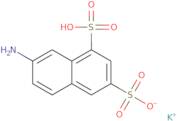Monopotassium 7-Amino-1,3-naphthalenedisulfonate Hydrate
CAS: 842-15-9
Ref. 3D-AAA84215
| 1kg | Discontinued | ||
| 50g | Discontinued | ||
| 100g | Discontinued | ||
| 250g | Discontinued | ||
| 500g | Discontinued |
Product Information
- 1,3-Naphthalenedisulfonic acid, 7-amino-, monopotassium salt
- 1,3-Naphthalenedisulfonic acid, 7-amino-, potassium salt (1:1)
- 2-Aminonaphthalene-6,8-disulfonic acid monopotassium salt
- 7-Amino-1,3-Naphthalenedisulfonic Acid Monopotassium Salt
- Andsap
- Monopotassium 7-aminonaphthalene-1,3-disulfonate
- Potassium 7-Amino-3-Sulfonaphthalene-1-Sulfonate
- Potassium hydrogen 7-aminonaphthalene-1,3-disulphonate
Monopotassium 7-Amino-1,3-naphthalenedisulfonate Hydrate (MKDS) is a fluorescent probe that has been used to study endoglycosidases, which are enzymes that cut glycosyl chains from the inner core of glycoproteins. This compound is also used to calibrate other fluorescent probes. It is most often used in conjunction with cyanuric acid and chloride ions as a pH indicator for microscopy. MKDS can be conjugated to oligosaccharides or polysaccharides to form an amide linkage and can be detected by labeling with fluorescein. The MKDS molecule emits light in the green region of the spectrum when excited by ultraviolet light at 350 nm and 436 nm wavelengths. The excitation wavelength can be changed by using different buffers or pH indicators. This compound has been shown to react with human serum albumin (HSA) in addition to Japonica cell culture proteins,





